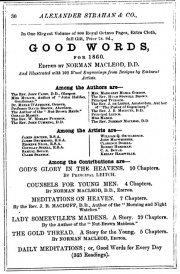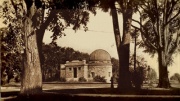The First Scientific Concept of Rockets for Space Travel by Robert Godwin Part 4
From The Space Library
Contents |
The Sun – Its Work and Structure
In the autumn of 1860 Leitch tried to explain the workings of the sun to his readers. The theories of his time didn’t include the notion of nuclear reactions and so he can be forgiven for not producing a modern analysis. In fact Mendeleyev’s periodic table was still several years in the future and the atom was considered irreducible until the discovery of the electron almost forty years after that. However, even allowing for this, Leitch demonstrated clear understanding that almost all of the options for energy on planet Earth are derived from the sun’s power. He discussed, wind, chemical and solar energy and even got into the subject of how there is an immutable amount of energy and matter in the universe. His peers had pondered how the sun seemed to be able to burn constantly without being replenished, and believing that this was in defiance of all known natural laws, they postulated that it was fuelled by the zodiacal light or a steady influx of comets. Variations of this theory survived for at least another 70 years and indeed were subscribed to by the Austrian Max Valier, who in 1930 became the first person to propel a manned vehicle with a liquid fuelled rocket. Leitch however wisely chose to reserve his own judgment on this hypothesis by stating “we have reached the boundaries of knowledge and even speculation is silent.” [1]
The Structure of the Planets & The Nebulae
In the last two months before his departure for Canada Leitch took on the task of explaining how the solar system might have formed. The prevailing theory was attributed to Simon Pierre de Laplace who had suggested the nebular hypothesis. By proposing that the solar system might have formed from a gradually cooling whirlpool of dust and gas Laplace had thrown one more wrench into the preconceptions of Christian orthodoxy. Inevitably this had upset many of Leitch’s learned colleagues in the Church but once again Leitch took a level-headed approach. In his mind the Laplace theory was elegant, but it was still unproven; and even if it proved to be true he saw nothing within the theory that diminished his belief in an intelligent hand at work. Indeed, Leitch chastised his fellow theologians for staking the existence of God on the refutation of the Laplace theory. “Instead of attacking the scientific theory, the proper attitude is to deny the religious inference. Instead of denouncing the theory as atheistical, the only tenable position is to show that, though granted, it would not warrant the atheistical deduction.
“Granting that the solar system was developed from a nebulous mist according to the rigid laws of mechanism, the question at once arises; who endowed the atoms of this mist with such properties and susceptibilities, as to form worlds, and plants and animals?” [2]
It is a question that still perplexes the brightest minds alive today. Indeed, many physicists have asserted that even a minor change to any of the basic forces in our universe would preclude our very existence. Leitch could not have known this but nevertheless he was a man guided by acceptance of the facts as they emerged. He was willing to accept that there were correlations between the design of the planets and the stars that showed obedience to some set of universal rules. The fact that he ascribed the existence of those rules to intelligent purpose was simply a mark of his circumstances. He even seems to have had some inkling of these natural tendencies from both the macroscopic and microscopic worlds, comparing tree rings to spiral galaxies, and in some small way presaging the findings of Mandelbrot and others in the years ahead.

Arrival in Canada
Leitch arrived in Kingston Ontario in October 1860. He arrived via Cunard steamer passing through Quebec (almost certainly his ship was the R.M.S. Canada.) Just as he was leaving the ship he was introduced to Fennings Hope, the Clerk Assistant of the Legislative Council of Canada. Hope immediately took a liking to Leitch and would later write a biography of him for photographer William Notman’s book of portraits entitled “Portraits of British North Americans".[3]
His first year in Canada was to be probational before he would agree to accept the post full-time. As has been previously noted his writings seem to imply that he might have been to Canada previously, but so far no solid evidence has come to light to support this. His earlier descriptions of Canadian forest fires, or of the tourists at Niagara Falls, may have come from hearsay. We also know that he owned a copy of William Hunter's Guide to Niagara Falls in his library. Regardless, we know with certainty that he arrived at Queen’s College and was inaugurated with some fanfare into the role of Principal of that body on November 8th 1860.[4]
It seems extremely unlikely that Leitch would have been dispatched to Kingston from Glasgow without having at least some insight into the political situation at Queens. However, one could be forgiven for assuming otherwise. As it happens, the challenge was one of some considerable proportion. The aforementioned endowment handed over by the monarch in 1798 had been the cause of significant agitation for the better part of three decades. When Leitch arrived he walked into a tangled web of political intrigue involving money, politics and power. Leitch was being paid $200 a month in his role as Principal and yet the purse strings were being held so tightly that he couldn’t even get travel expenses. [5]
The University Question
When George III had gifted the land to the people of Canada it was assumed that much of it would be sold to raise money to establish a system of schools and seats of higher learning. Understandably the various denominational schools, like Queens, assumed that they would be given a piece of that endowment’s earnings to operate their schools. This same assumption was duplicated by the authorities at schools run by the Methodists, Catholics, Baptists, Anglicans and the Presbyterians (represented primarily by Queens in Kingston.)
Several acts of the government had been passed during the intervening years to resolve this dilemma, and when Leitch arrived he tackled the problem with his usual articulate intelligence. In his mind he saw a school system akin to that which he had seen in Glasgow and Oxford. There should be one university for examining and bestowing diplomas and degrees; and a series of satellite colleges to teach the curriculum to the students. In his mind all of the key subjects could be standardized with the exception of Divinity which he freely acknowledged might take on a different shape in each school. This was his solution to what must have seemed a fairly straight-forward problem. [6]
Before he took on the fight for the future of Canada’s educational system he first set about establishing the Botanical Society of Canada. He became the society’s first president. His interest in plants undoubtedly came from his work with Thomas Brown in Scotland. Combined with his solid understanding of bees he must have made a persuasive teacher on this subject.[7] He also established a new Faculty of Law at Queens and appointed a fellow Scot named Alexander Campbell to run it. Campbell was partner in a Kingston law firm with the town’s most distinguished resident, John A. Macdonald, destined to become Canada’s first Prime Minister, while Campbell would later become Lt. Gov. of Ontario and a Canadian Senator.
Having barely been on the job for four months the observer is left to assume that Leitch must have looked at the College’s finances and determined that he needed to delve into the endowment issue with all of his talents. On Wednesday March 6th 1861 the largest gathering ever assembled of the residents of Kingston took place in the City Hall to attend to what seems to have been the general opinion that Queen’s College was being swindled of its share of the King’s endowment. The main speaker that night was Leitch. His speech would later be printed and disseminated and was spread over 15 pages. Having barely arrived in his new country he had staked his fortunes on one side of a fight which would not be resolved in his lifetime and, some people at the time believed, contributed to his early death. [8]
The Kingston Observatory and Alvan Clark
But before the fight for educational rights consumed him, Leitch quickly turned to his great love, astronomy. One of the first things he undertook to resolve was to transfer control of the Kingston Observatory to the College. The observatory had been announced in 1855 with the express purpose of providing a world-class facility for the students. It had been built with subscriptions and with optics furnished by one of the best manufacturers in the United States. In 1861 Leitch arranged the building of a more permanent brick structure to house the instruments.
In the summer of 1861 Leitch returned to Scotland. His children remained there and demanded his attention. The journey took him via Cambridge Massachusetts where he visited Alvan Clark, one of the most accomplished makers of optical instruments in the world. Leitch was presumably there to discuss the capabilities of the Kingston equipment which Clark had provided. Leitch was so impressed by Clark’s work that he wrote an essay about him for publication in Good Words. Of incidental interest was the fact that the American Civil War was in its first few months when he arrived in Boston. The enthusiasm of the rallying troops caught his attention. He even cited an extract from a song on everyone’s lips, the lyrics being those penned by Francis Scott Key and ultimately destined to become the American national anthem. However, Leitch was evidently quietly saddened by the spectacle and stated, “It was gratifying to find one man engaged in the peaceful pursuits of science.” [9]
Leaving Clark to his lenses and polishing, Leitch embarked on a steamer for Scotland. It is at this time that we are obliged to carefully consider the dates and times to allow us to make any assumptions about his next, and possibly most important, scholarly work. Click here for Part 5
Footnotes
- ^ Good Words, Strahan, Edinburgh, #37 September 1860
- ^ Ibid. #40 October 1860
- ^ Portraits of British North Americans by William Notman, Montreal, 1865
- ^ Globe, Toronto, Nov. 10, 1860
- ^ Documentary History of Education in Upper Canada by J. George Hodgins, Vol 18, Cameron, Toronto, 1907
- ^ Globe, Toronto, Apr. 14 1849
- ^ The Journal of the Boards and Arts and Manufactures for Upper Canada, Vol.1, 1861
- ^ University Reform Report of the Resolutions Adopted at a Great Public Meeting of the Inhabitants of Kingston, 1861
- ^ American Telescopes and Astronomers, Good Words, Strahan, London, July, 1861

